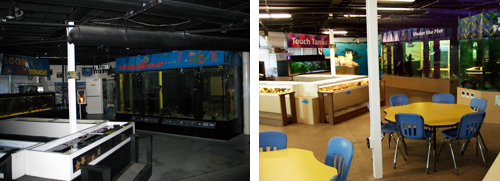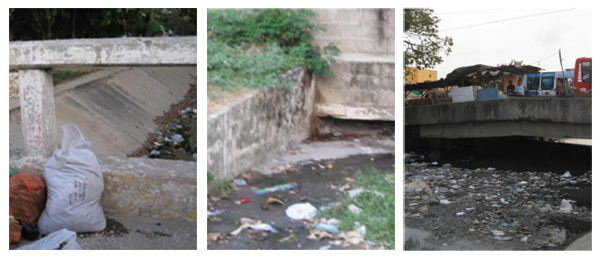This is the final installment of a four-part series on the many changes the Santa Monica Pier Aquarium has undergone since March 1, 2003, when Heal the Bay took over management and ownership of the marine education center. This blog was authored by Aquarium Director Vicki Wawerchak.
Pollution prevention and environmental stewardship are two messages infused into the programs at the Santa Monica Pier Aquarium. From learning about storm drains vs. sewers in our field trip education program, to training volunteers to educate the public about our Beach Report Card, the “Pollution Corner” plays an integral role in educating the students and adults about the impacts humans can have – both positively and negatively – on the ocean environment. This exhibit has been transformed into the perfect platform for discussing the latest in plastic bag legislation, but it took awhile for the display to become the popular spot it is today.
The pollution corner, an oddly-shaped area in the far corner of the gallery, has undergone a few variations. When Heal the Bay originally took over the facility it was the UCLA Ocean Discovery Center’s donor wall, which was painted a bright shade of goldenrod. One of the first designs integrated into the corner consisted of an interactive trash timeline, a storm drain versus sewer poster, images of the impacts of pollution on marine life and an eight-foot tall, three-dimensional sculpture of a storm drain with an imbedded video monitor. New teaching elements were introduced along the way including a “butt-o-meter,” a tall acrylic cylinder that was filled to the top with cigarette butts to show just how many were picked up during a beach cleanup, followed by information regarding our partnership with Monterey Bay Aquarium’s seafood watch program.

After many years of trying to figure out what would work well in this challenging space, we enthusiastically settled on the latest rendition. The current pollution corner includes an open ocean exhibit with a sea jelly kreisel (a round tank specially designed to protect the fragile structure of a jelly) filled with majestic moon jellies. Floating inside a tank alongside the kreisel are the remnants of plastic bags and balloons. This exhibit demonstrates the similarities between sea jellies and plastic marine debris in the ocean environment, allowing the visitor to understand how marine life can mistake plastic debris for food, often resulting in death through starvation and choking. A three-dimensional color mural, which also illustrates the negative impact of plastic debris on marine life, is highlighted as well.
I hope you will drop by Heal the Bay’s Santa Monica Pier Aquarium and experience everything it now has to offer after years of improvements.
Read part three of our four-part series.




